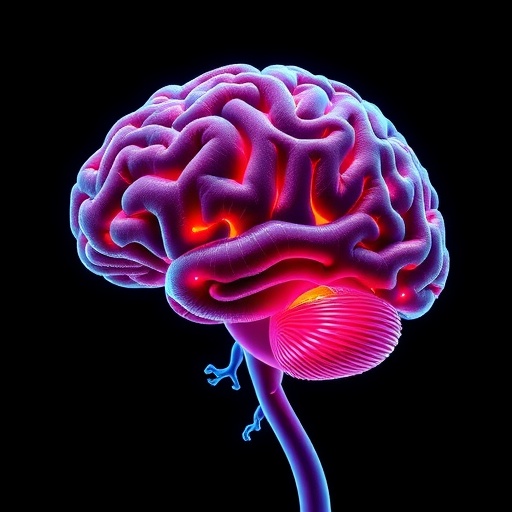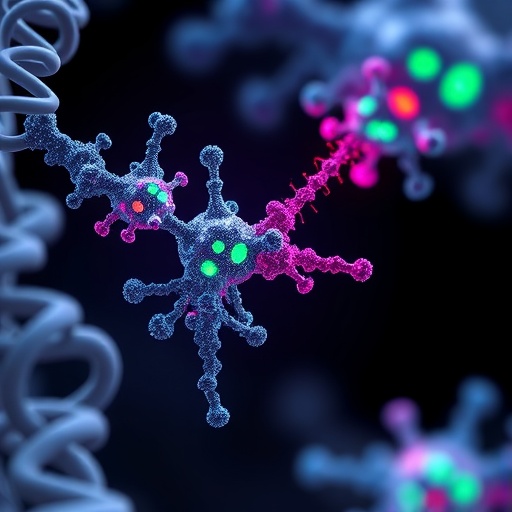In a groundbreaking study published in Nature Communications, scientists have unveiled critical insights into cerebral palsy by harnessing the power of serum proteomics. This innovative approach has enabled the identification of precise diagnostic biomarkers and the delineation of underlying molecular pathways, offering a transformative window into the complex pathophysiology of this neurodevelopmental disorder. Cerebral palsy, a lifelong condition characterized by impaired movement and posture, affects millions worldwide, yet its biological underpinnings remain elusive. The study, led by a team of researchers including Xu, Ma, and Sun, represents a significant leap forward in understanding and potentially diagnosing cerebral palsy with high specificity and sensitivity.
Proteomics—the large-scale study of proteins and their functions—is pivotal when it comes to deciphering the molecular landscape of diseases. In this context, serum proteomics leverages blood serum samples as a minimally invasive resource to investigate systemic changes associated with cerebral palsy. By analyzing the protein composition and fluctuations in patient serum, researchers can decode disease-specific signatures, reflecting cellular disturbances occurring in affected brain regions. This innovative technique surpasses traditional diagnostic methods, which rely heavily on clinical evaluations and imaging, providing a molecular dimension to diagnosis and prognosis.
The researchers embarked on a comprehensive proteomic analysis of serum samples collected from cerebral palsy patients and healthy controls. Using cutting-edge mass spectrometry and bioinformatics tools, they catalogued thousands of proteins, comparing their expression profiles between the two cohorts. This rigorous workflow filtered through vast datasets to pinpoint proteins whose levels fluctuate markedly in cerebral palsy, highlighting novel biomarkers that were previously unidentified. These biomarkers may serve as reliable windows into pathological processes such as neuroinflammation, neuronal injury, and impaired synaptic signaling.
One of the study’s most compelling findings lies in the identification of a specific panel of proteins that effectively differentiates cerebral palsy subjects from healthy individuals. These proteins were predominantly linked to immune modulation and metabolic dysregulation, illuminating how systemic inflammation and energy metabolism play integral roles in disease mechanisms. The key biomarkers detected hold immense potential not only for early diagnosis but also for stratifying patients based on disease severity and progression. This could personalize clinical management, allowing tailored interventions to improve functional outcomes.
Delving deeper into molecular pathways, the proteomic analysis exposed significant alterations in signaling cascades related to oxidative stress and cytoskeletal remodeling. These pathways are fundamental to neuronal development and synaptic plasticity—processes that are disrupted in cerebral palsy. The data suggest that oxidative damage and structural instability within neural networks contribute to the motor impairments characteristic of the disorder. Understanding these pathways at the protein level enriches the field’s knowledge beyond genetic predispositions, framing cerebral palsy as a complex interplay of environmental insults and molecular vulnerabilities.
Equally important, the study integrated advanced bioinformatics to perform pathway enrichment and network analyses, mapping the proteomic alterations onto known biological systems. This holistic perspective allowed the researchers to construct a web of interacting proteins, outlining how defects cascade through various molecular processes. These interactions form a quintessential network of dysregulated proteins driving disease manifestation, offering numerous potential targets for therapeutic intervention. The intricate molecular map provides a valuable framework for future research focused on reversing or mitigating pathway dysfunctions.
A major strength of this investigation lies in its clinical applicability. By focusing on serum, accessible through simple blood draws, the identified biomarkers hold promise for translation into diagnostic tests usable in routine clinical settings. This contrasts starkly with current diagnostic procedures, which rely on complex neuroimaging and clinical observation that can delay definitive diagnosis. Early and accurate diagnosis enabled by serum biomarkers could drastically improve intervention timing, which is critical in neurodevelopmental disorders when early therapies most effectively modulate brain plasticity.
Moreover, the researchers propose that these serum biomarkers may also serve as surrogate endpoints in clinical trials, offering objective measures to evaluate therapeutic efficacy. This would propel cerebral palsy research forward by facilitating robust assessment of new drugs or rehabilitative strategies. Biomarker-guided trials could overcome the subjective bias inherent in clinical assessments, standardizing outcome measures and accelerating the approval of novel treatments aimed at modifying disease course instead of merely managing symptoms.
From a methodological standpoint, the application of high-resolution mass spectrometry combined with sophisticated proteomic workflows exemplifies the power of modern analytical techniques in medical research. The ability to sensitively and specifically quantify thousands of proteins simultaneously is a game-changer in biomarker discovery. Furthermore, the multi-layered data analysis integrating pathway construction and network biology strengthens the biological relevance of the results, bridging the gap between molecular findings and pathophysiological relevance.
The study also underscores the importance of collaborative multidisciplinary efforts, blending clinical neurology, proteomics, computational biology, and bioinformatics. Such integrated approaches are essential to untangling multifaceted diseases like cerebral palsy, which stem from complex genetic-environmental interactions. By leveraging diverse expertise and high-throughput technologies, the research team has set a new benchmark for translational neuroscience research focused on neurodevelopmental disorders.
Looking ahead, these findings pave the way for expanded proteomic studies involving larger patient cohorts and longitudinal sampling. Such studies would validate and refine the biomarker panel, assessing its robustness across demographic variables and over disease progression. Additionally, coupling proteomics with other omics platforms, such as genomics and metabolomics, could offer more comprehensive molecular portraits, enhancing predictive accuracy and mechanistic insight.
Importantly, future research must also explore therapeutic targeting of the identified molecular pathways. Drugs modulating immune responses, oxidative stress, or cytoskeletal dynamics could hold promise in altering disease trajectories if validated in preclinical and clinical trials. This represents a paradigm shift toward molecularly informed precision medicine in cerebral palsy, moving beyond symptomatic treatments toward interventions that address root causes.
The societal implications of such advancements cannot be overstated. By providing objective, early detection tools and potential novel therapeutic targets, this research holds potential to transform the quality of life for individuals with cerebral palsy worldwide. Early diagnosis allows timely initiation of therapies that harness neuroplasticity, maximizing functional improvements. Furthermore, biomarker-led stratification enables personalized rehabilitation programs, ultimately reducing healthcare burdens and improving long-term outcomes.
In sum, the work by Xu, Ma, Sun, and colleagues represents a milestone in cerebral palsy research, combining proteomics and bioinformatics to reveal novel biomarkers and molecular pathways. Their findings chart a bold new course for diagnosis and treatment, emphasizing the power of serum proteomics as a minimally invasive yet deeply informative strategy. As the field moves toward an era of molecularly guided neurodevelopmental care, such insights will be instrumental in reshaping clinical paradigms and improving patient lives.
This seminal study highlights how transforming traditional diagnostic landscapes through cutting-edge technologies can revolutionize our understanding of complex neurological disorders. The potential to move cerebral palsy diagnostics out of the clinic and into routine blood tests exemplifies the democratization of precision medicine. As proteomic techniques continue to evolve and integrate with computational biology, we stand on the brink of an unprecedented age in neurodevelopmental disease management driven by molecular insights and personalized care strategies.
The intersection of advanced proteomic profiling and neurodevelopmental pathology unveiled here foreshadows a broader revolution in medicine—where biological complexity is unraveled through data-rich molecular layers, fostering breakthroughs in vulnerable populations. Researchers worldwide will undoubtedly build on this foundation, accelerating the dawn of innovative diagnostics and targeted therapies for cerebral palsy and beyond. This study is a clear testament to the promise of systems biology to decode one of medicine’s most persistent challenges.
Subject of Research: Biomarker discovery and molecular pathway elucidation in cerebral palsy through serum proteomics.
Article Title: Serum Proteomics Reveals Diagnostic Biomarkers and Molecular Pathways in Cerebral Palsy.
Article References:
Xu, Y., Ma, C., Sun, Y. et al. Serum Proteomics Reveals Diagnostic Biomarkers and Molecular Pathways in Cerebral Palsy. Nat Commun 16, 10253 (2025). https://doi.org/10.1038/s41467-025-65110-6
Image Credits: AI Generated
DOI: https://doi.org/10.1038/s41467-025-65110-6
Tags: biomarkers for cerebral palsydiagnostic methods for cerebral palsyidentifying disease-specific signaturesimplications of proteomics in medicineinnovative diagnostic techniquesmolecular pathways in cerebral palsyneurodevelopmental disorders researchnon-invasive diagnostic biomarkersprotein analysis in blood serumserum proteomicsunderstanding cerebral palsy pathophysiologyXu Ma and Sun research team





